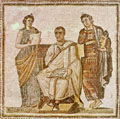Bibliography
Virgil’s Aeneid
Essential: a) Please read the Aeneid in English (recommended edition: D. West 2003, Penguin Classics; but F. Ahl 2007 edition is also available online and has excellent notes!). b) please read Book 5 in Latin (in the course of the Autumn term).
Optional: Excellent starting points for critical interpretations are: Hardie 1998 (an introduction to the poem), the companions by Martindale (1997), Horsfall (2000), and Farrell and Putnam (2010), and the selection of essays collected in Harrison (1990), and Hardie (1999).
The following bibliography includes other important works on the Aeneid available in the University Library. These works are optional for you to consult, but we may refer to them, or read extracts, during the course of the first term:
Cairns, F. (1989) Virgil’s Augustan Epic, Cambridge. [ebook]
Camps, W.A. (1969) An Introduction to Virgil’s Aeneid, London [printed resource]
Clausen, W.V. (1964) ‘An interpretation of the Aeneid’, HSCP 68: 139- 47.
Conte, G.B. (2007) The Poetry of Pathos: Studies in Epic, Oxford. [ebook]
*Farrell, J. and Putnam, M.C.J. (2010) (eds.) A Companion to Vergil’s Aeneid and its Tradition, Malden MA [ebook].
Hardie, P.R. (1986) Virgil’s Aeneid: Cosmos and Imperium, Oxford [printed resource]
* Hardie, P.R. (1998) Virgil, Oxford [printed resource]
* Hardie, P.R., ed. 1999. Virgil. Critical assessments of classical authors, vols 3-4, London (classic articles) [printed resource]
*Harrison, S.J. (ed.) (1990) Oxford readings in Virgil’s Aeneid, Oxford (classic articles) [printed resource]
*Horsfall, N. (2000) A Companion to the Study of Virgil, Leiden [ebook]
Johnson, W.R. (1979) Darkness Visible: A Study of Vergil’s Aeneid, Berkeley [printed resource]
Kennedy, D. 'Augustan and anti-Augustan. Reflection on terms of reference.' In Powell, A. (ed.) Roman Poetry and Propaganda in the Age of Augustus, London
Lyne, R.O.A.M. (1987) Further Voices in Vergil’s Aeneid, Oxford [printed resource]
*Martindale, C. (ed.) (1997) Cambridge Companion to Virgil, Cambridge [ebook]
O’Hara, J.J. (1990) Death and the Optimistic Prophecy in Vergil’s Aeneid [printed resource]
Parry, A. (1963) ‘The Two Voices of Virgil’s Aeneid’, Arion 2, 66-80.
Pöschl, V. (1970) The Art of Vergil: Image and Symbol in the Aeneid, Ann Arbor [printed resource]
Quinn, K. (2006) Virgil’s Aeneid: A Critical Description, Bristol [printed resource]
Ross, D.O. (2007) Virgil’s Aeneid: A Reader’s Guide, Malden MA [ebook]
Thomas, R.F. (2001) Virgil and the Augustan Reception, Cambridge [ebook]
Thomas, R.F. and J. M. Ziolkowski (eds) (2014) The Virgil encyclopedia, 3 vols, Malden MA (bite-sized summaries of names, topics, authors, etc.)
Aeneid on jstor: http://www.aeneidinjstor.eu/
Cicero's Verrines
Essential: Read the Fifth Verrine Oration in Latin with the commentary and introduction of R.G.C. Levens (R.G.C. Levens, The Fifth Verrine Oration, 1980, London: Bristol Classical Press), and the Verrines in English (recommended translation: L.H.G. Greenwood 2014, Loeb Classical Library)
Optional: The following bibliography includes other important works on Cicero's Verrines available in the University Library. These works are optional for you to consult, but we may refer to them, or read extracts, during the course of the first term.
Atkinson, J.E. (1992) 'Cicero and the trial of Verres', Akroterion 37, 3-4.
Butler, S. (2005) The Hand of Cicero, Routledge.
Frazel. T. D. (2004) 'The Composition and circulation of Cicero's In Verrem', CQ 54.1, 128-42.
Gurd, S. (2010) 'Verres and the Scene of Rewriting', Phoenix 64, 80-101
Tempest, K. (2007a) 'Cicero and the art of dispositio: the structure of the Verrines', Leeds International Classical Studies, 1-25.
Tempest, K. (2007b) 'Saints and Sinners: Some Thoughts on the Presentation of Character in Attic oratory and Cicero's Verrines', BICS 97, 19-36.
Van der Blom, H. (2010) Cicero’s Role Models: The Political Strategy of a Newcomer, Oxford [e-book]
--- (2016) Oratory and Political Career in the late Roman Republic, Cambridge [e-book]
Vasaly, A. (2009) 'Cicero, domestic politics, and the first action of the Verrines', ClAnt 28.1, 101-137.

